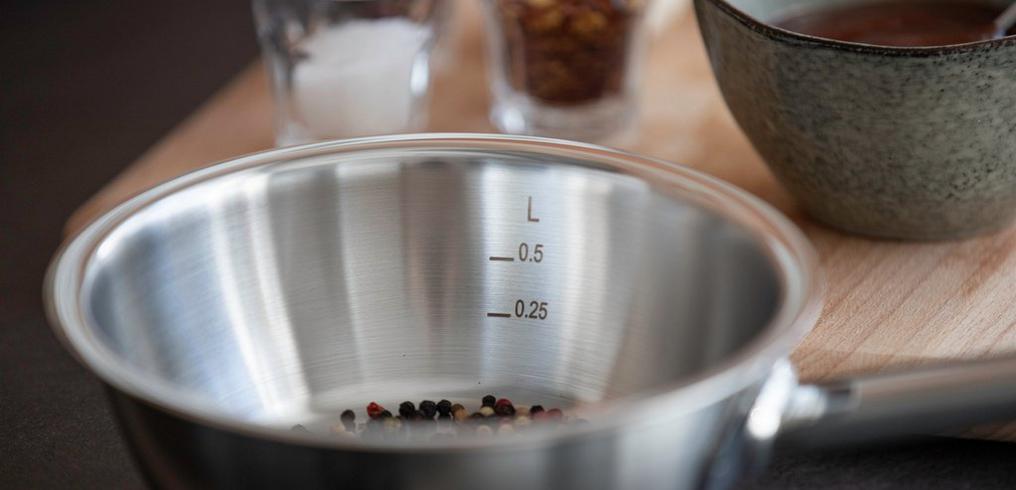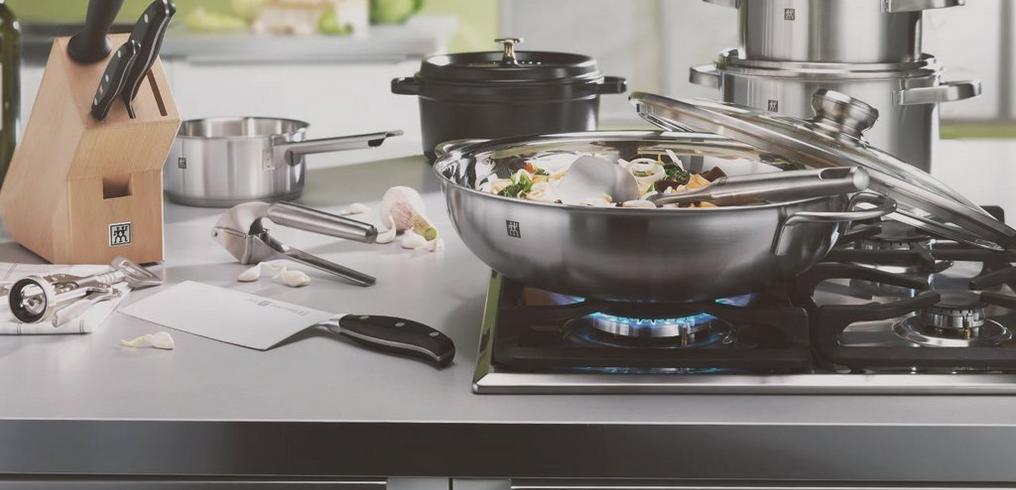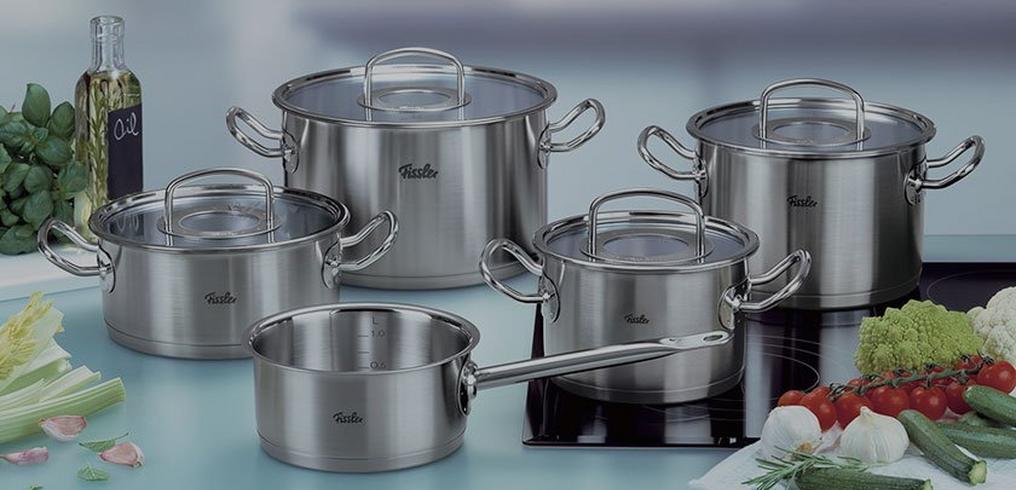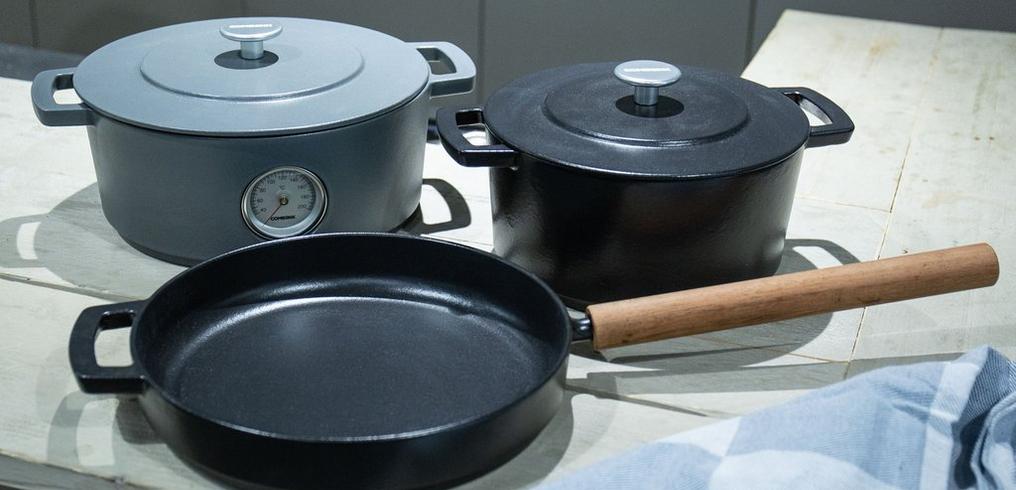Seasoning your stainless steel, cast-iron and sheet-steel pans
Seasoning iron pans is an age-old technique that not only improves their cooking performance, it also extends the lifespan of your pans. Whether you are a professional or an amateur chef, by understanding the process of seasoning, you will unlock the full potential of your stainless steel frying pans, carbon-steel pans and cast-iron pans! In this guide, we will explain the best way to season your pans. With step-by-step instructions and tips for each type of pan. By mastering these techniques, you will create a natural non-stick coating, which will prevent corrosion. As a result, you'll be able to enjoy cooking with pans that will last for generations.
Seasoning a carbon-steel pan
Seasoning carbon-steel pans will create a natural non-stick coating, improving flavour and resulting in a better heat retention. It also helps prevent rust and improves the longevity of the pan!
How to season a carbon-steel pan:
- Remove the protective coating. Some sheet-steel pans, such as the DeBuyer Mineral B pans, have a thin layer of beeswax from the factory to prevent corrosion. You'll need to remove this layer before seasoning the pan. You do this by washing the pan with warm water and a mild detergent. Rinse the pan and dry it well.
- Apply a thin layer of oil. Choose an oil with a high smoke point, like linseed oil or grapeseed oil. Cover the entire surface of the inside of the pan. That includes the edges!
- Heating the pan: place the pan on the large burner of a stove over medium-high heat, or in a preheated oven at a temperature of about 200°C. Let the pan heat for a few minutes so the oil can bond to the metal (polymerisation). When the oil starts to smoke, remove the pan from the fire.
- Carefully remove excess oil. Wait for the pan to cool off and use a paper towel or a clean cloth to wipe down the pan.
- Repeat applying, heating and removing excess oil several times until the bottom of the pan has become slightly brown. Usually, around 5 times is enough.
- Wait for the pan to cool down completely before using it or storing it.
- Your carbon-steel pan is now seasoned and ready for use!
Seasoning the outside of a carbon-steel pan?
Seasoning the exterior of a carbon-steel pan is not technically necessary for its cooking performance, but it can provide extra protection against rust and improve the overall appearance. Seasoning the outside of a carbon-steel pan is a similar process to seasoning the inside:
- Clean the outside of the pan: use warm water and a mild detergent to remove dirt from the pan. Rinse the pan and dry it well.
- Apply a thin layer of oil to outside of the pan. Choose an oil with a high smoke point, like linseed oil, rapeseed oil or grapeseed oil.
- Heating the pan: place the pan upside down in a preheated oven at about 200°C. Let the pan heat for a few minutes so the oil can bond to the metal (polymerisation).
- Wipe away excess oil. Wait for the pan to cool off and use a paper towel or a clean cloth to wipe down the pan.
- Repeat applying, heating and removing excess oil several times until the outside of the pan has become slightly brown.
- Wait for the pan to cool down completely before using it or storing it.
Seasoning the exterior of a carbon-steel pan is mainly done for aesthetic purposes and to provide an extra layer of protection against rust. However, it is not as vital as seasoning the inside of the pan.
Seasoning stainless-steel pans
Although stainless steel is famous for its durability and rust resistance, seasoning a stainless-steel frying pan can still improve its the non-stick properties. Seasoning a pan will form a protective layer that will prevent food from sticking to the pan and ensure an even distribution of heat. Seasoning a stainless-steel pan works the same as seasoning a carbon-steel pan.
How to season a stainless-steel pan:
- Clean the pan with warm water and a mild detergent to remove any dirt.
- Rinse the pan and dry it well.
- Remove the protective coating. Some sheet-steel pans, such as the DeBuyer Mineral B pans, have a thin layer of beeswax from the factory to prevent corrosion. You'll need to remove this layer before seasoning the pan. You do this by washing the pan with warm water and a mild detergent. Rinse the pan and dry it well.
- Apply a thin layer of oil. Choose an oil with a high smoke point, like linseed oil or grapeseed oil. Cover the entire surface of the inside of the pan. That includes the edges!
- Heating the pan: place the pan on the large burner of a stove over medium-high heat, or in a preheated oven at a temperature of about 200°C. Let the pan heat for a few minutes so the oil can bond to the metal (polymerisation). When the oil starts to smoke, remove the pan from the fire.
- Carefully remove excess oil. Wait for the pan to cool off and use a paper towel or a clean cloth to wipe down the pan.
- Repeat applying, heating and removing excess oil several times until the bottom of the pan has become slightly brown. Usually, around 5 times is enough.
- Allow the pan to cool down. Wait for the pan to cool down completely before using it or storing it.
- Your stainless-steel pan is now seasoned and ready for use!
Seasoning cast-iron pans
As with other types of pans, seasoning cast-iron pans will create a natural non-stick coating that protects against rust. Most pans, and almost all cast-iron pans on this website, are pre-seasoned. That means that these pans have received a natural coating from the factory to protect against rust and dust. Perfect, since the pan might spend some time in our warehouse! However, it is still beneficial to season the pan in order to develop a better non-stick coating.
How to season a cast-iron pan:
There are several effective ways to season a cast-iron pan. Here are some options:
- In the oven: this method is popular and easy. Apply a thin layer of vegetable oil to the entire surface of the pan, both inside and outside. Place the pan in a preheated oven at about 200°C and bake for 1 to 2 hours. Let the pan cool down in the oven. Repeat this process a few times for the best result.
- On the stove: this is a practical alternative if you don't have an oven. Apply a thin layer of oil to the inside and outside of the pan. Heat the pan on the stove on medium heat and allow the oil to heat up and start and smoking. Move the pan during the process to ensure the oil is evenly distributed. Allow the pan to cool off and repeat the process a few times.
- With a camp fire: the most fun way of seasoning your cast-iron pan is over a fire. Clean the pan well and apply a thin layer of oil. Place the pan on the grill over the fire or on the barbecue and let it heat up for 20-30 minutes. Allow the pan to cool down and repeat the process if necessary. Regardless of which method you choose, it's important to apply a very thin layer of oil and to make sure it's evenly distributed, covering the entire surface of the pan. When the oil starts to smoke, remove the pan from the oven or the stove. Repeat the seasoning process several times to create a strong layer. Remember to be careful when handling hot pans and always take the necessary safety precautions. If you are not going to use the cast-iron pan for a while, we recommend applying a coat of oil to it. You can use coconut oil, sunflower oil, Petromax Care and Seasoning Conditioner or the Lodge Seasoning Spray.
Pro tip:
You can also season your pan over an open fire! The larger the heat source, the more even the result. Please note that the bottom of the pan can get a little dirty if you do this.
Conclusion
Seasoning a pan is a transformative process that can significantly improve cooking performance and durability. By following the right steps for stainless steel, carbon steel or cast-iron pans, you can create a natural non-stick coating, preventing rust and allowing you to enjoy your favourite dishes for years to come. Remember to take good care of your seasoned pans by avoiding aggressive cleaning products and always dry them properly to avoid moisture-related problems. With proper seasoning and maintenance, these pans will become beloved kitchen buddies, providing a lifetime of delicious meals and culinary adventures.


?%24center=center&%24poi=poi&%24product-image%24=&fmt=auto&h=490&poi=%7B%24this.metadata.pointOfInterest.x%7D%2C%7B%24this.metadata.pointOfInterest.y%7D%2C%7B%24this.metadata.pointOfInterest.w%7D%2C%7B%24this.metadata.pointOfInterest.h%7D&scaleFit=%7B%28%24this.metadata.pointOfInterest%29%3F%24poi%3A%24center%7D&sm=c&w=1016)


?%24center=center&%24poi=poi&%24product-image%24=&fmt=auto&h=490&poi=%7B%24this.metadata.pointOfInterest.x%7D%2C%7B%24this.metadata.pointOfInterest.y%7D%2C%7B%24this.metadata.pointOfInterest.w%7D%2C%7B%24this.metadata.pointOfInterest.h%7D&scaleFit=%7B%28%24this.metadata.pointOfInterest%29%3F%24poi%3A%24center%7D&sm=c&w=1016)

